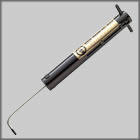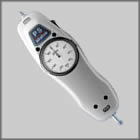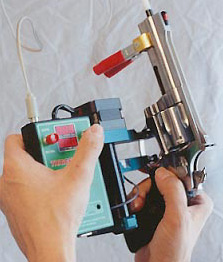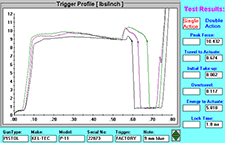Home | Glossary | Resources | Help | Contact Us | Course Map
Archival Notice
This is an archive page that is no longer being updated. It may contain outdated information and links may no longer function as originally intended.
Trigger Pull Measurements
Trigger pull is a measurement that can assist in determining the level of difficulty related to discharging a particular firearm. Various types of firearms will have a range of typical trigger pulls.
Range of Typical Trigger Pulls
| Typical Trigger Pulls | |
| Firearm | Trigger Pull Range |
| .22 caliber rimfire rifles |
3 lb to 5 lb |
| Military rifles |
4 lb to 7 lb |
| Single-action revolvers |
4 lb to 6 lb |
| Double-action revolvers |
10 lb to 15 lb |
| Semiautomatic pistols |
4 lb to 5 lb |
These ranges are typical, but there may be exceptions. If a trigger pull is measured by an examiner and it falls outside of known factory specifications or the ranges shown above, then it would be advisable for the examiner to determine the cause. Trigger pull values can point to other root causes of functional and operational problems.
There are a number of reasons for unusual trigger pull values; they may include
- inherent design characteristics,
- poor quality factory assembly work,
- customization of a firearm,
- flawed lock mechanism,
- flawed safety feature.
Measuring the trigger pull range in single- and/or double-action modes is the first step in identifying many of these problems.
| Note: |
| Occasionally a suspect in a case will indicate that the firearm had a hair trigger (a very imprecise term that examiners should avoid), causing an inadvertent or accidental discharge. In these cases, the firearm examiner should measure the trigger pull. However, if asked in court, it would be wise to strictly avoid using this information as a basis for an opinion regarding the shooters state of mind. This is scientifically unknowable and lies outside the expertise of a firearm examiner. This line of questioning can be defused during a comprehensive pretrial conference. |
There are several approaches to measuring trigger pull, including the use of
- standard trigger weights,
- a spring gauge,
- mechanical trigger pull testers,
- digital trigger pull testers,
- the TriggerScan system.
Each technique requires different equipment and protocols, which will be addressed in more detail in Module 8, Examination of Firearms.
It should be noted that there are common conceptual threads in each of the techniques:
- A range of trigger pull values must be established.
- Multiple tests should be performed to establish reproducibility within the range of values.
- Contemporaneous documentation must be kept for each test result.
- Results can be expressed as a range of weights:
- From a low end at which the trigger never releases the sear.
- To an upper end at which the trigger always releases the sear.
Standard Trigger Weights
Standard trigger pull weights (typically used by gunsmiths and the National Rifle Association) have been used by firearm examiners for many decades. They are effective when weight is carefully added in small increments. Excellent data is produced if the weights are suspended from a point on the trigger where the finger would rest and exert pressure to the rear.
Spring Gauges
The use of spring gauges is another traditional approach to measuring trigger pull. Firearm examiners required to perform testing outside of the laboratory prefer spring gauges because they are lightweight and easily calibrated.
|
|
|
Mechanical Testers
A nondigital device, the mechanical trigger pull tester dates back to the 1970s. These can be mounted or handheld, depending on brand and design. Using various rod-type adapters, mechanical trigger pull testers can be used for both handguns and long guns. They are portable and can typically be calibrated by turning the bezel-type ring around the needle indicator. Peak values are recorded, but no digital information in the form of charts or graphs is provided for case documentation.
Digital Trigger Pull Testers
Digital trigger pull testers are push and pull testing devices that usually have rod-like adapters for measuring trigger pull for both handguns and long guns. The basic unit can usually be handheld or mounted permanently.
These instruments are innovative because they capture and store information relating to the full range of trigger motion: the pressure exerted and the distance traveled as the force on the trigger begins, increases, and goes to zero at sear release. Optional software that allows for real-time data porting into a computer as well as a software interface accessed from the computer keyboard may be available. The graphical results represented as a color-coded force versus distance plot in different types of units can be saved for use as case documentation.
Calibration requirements are brand specific and should be adhered to as required.
The TriggerScan System
TriggerScan is an advanced system engineered specifically for gunsmiths and firearm examiners. It is not an industrial tool retrofitted for a special use.
The system employs a mounting fixture for various types of firearms. The fixture makes it easier to mount firearms uniformly and to mount the motorized sensor arm that protrudes into the trigger guard and squeezes the trigger to the rear. The software allows for control by keyboard or from the body of the sensor. The test results are displayed on-screen in both graphical and tabular forms. The data can be stored, printed, and retrieved for case documentation. The data are completely annotated and can be customized with information, such as case identifiers, date/time, serial numbers, double action, single action, and name of the individual performing the test.
The printouts are multicolored and display a force versus distance plot, including the initial trigger travel, maximum force, and the point at which the trigger pull drops to zero after firing.
The system includes a calibration tool for making adjustments against a known standard. The manufacturer will also perform the calibration service.
Additional Online Courses
- What Every First Responding Officer Should Know About DNA Evidence
- Collecting DNA Evidence at Property Crime Scenes
- DNA – A Prosecutor’s Practice Notebook
- Crime Scene and DNA Basics
- Laboratory Safety Programs
- DNA Amplification
- Population Genetics and Statistics
- Non-STR DNA Markers: SNPs, Y-STRs, LCN and mtDNA
- Firearms Examiner Training
- Forensic DNA Education for Law Enforcement Decisionmakers
- What Every Investigator and Evidence Technician Should Know About DNA Evidence
- Principles of Forensic DNA for Officers of the Court
- Law 101: Legal Guide for the Forensic Expert
- Laboratory Orientation and Testing of Body Fluids and Tissues
- DNA Extraction and Quantitation
- STR Data Analysis and Interpretation
- Communication Skills, Report Writing, and Courtroom Testimony
- Español for Law Enforcement
- Amplified DNA Product Separation for Forensic Analysts







